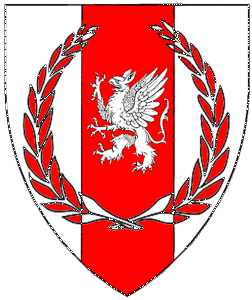So you’ve heard someone being called ‘Master’ or ‘Mistress’, or maybe you’ve just run across some confusing terminology. What’s this peerage thing about? What’s the difference between a fighter and a knight? Why are we calling people ‘pelicans’?
The peerages are the highest-level awards granted in the SCA, and our peers are some of the most respected members of our community. These awards recognise mastery in a particular field (armoured combat, rapier, arts and sciences, or service), but no-one becomes a peer unless they also act the way we think a peer should act. There’s a lot of discussion about what it is exactly that makes someone worthy to be a peer, but there are some common themes: they should be courteous and respectful to others, committed to sharing their knowledge and skills, play a significant role in our community, and generally be the sort of person we like to look up to.
There are four peerage orders focused on mastery in particular fields, and each one meets regularly with the Crown to discuss matters concerning their field, and to consider potential candidates to join that order. There are also the Royal Peers, who are a special case.
The Order of Chivalry
The Order of Chivalry recognises excellence in Armoured Combat. Members of the Order of Chivalry are called knights (or masters-at-arms, in some cases), and use the title ‘Sir’. Some female knights prefer ‘Dame’, but ‘Sir’ is considered gender-neutral. Knights wear a white belt (or a white baldric, if they are masters-at-arms), and if they have sworn loyalty to the Crown, they may wear an unadorned chain necklace (called a ‘fealty chain’).
The Order of the Laurel
The Order of the Laurel recognises excellence in the Arts and Sciences. Generally, this means excellence in a particular field within the arts and sciences, such as costuming, brewing, or dance. Members of the Order of the Laurel are often called ‘Laurels’, and use the title ‘Master/Mistress’. They wear a medallion depicting a laurel wreath, and if they have sworn loyalty to the Crown, a fealty chain.
The Order of the Pelican
The Order of the Pelican recognises excellence in service. These are the people who have dedicated their efforts and skill to running events, holding officer positions, creating community, and doing unpopular jobs that need to get done. Members of the Order are often called ‘Pelicans’, and use the title ‘Master/Mistress’. They wear a medallion depicting a pelican (in the heraldic pose ‘a pelican in her piety’), and if they have sworn loyalty to the Crown, a fealty chain.
The Order of Defence
The Order of Defence recognises excellence in Rapier Combat. Members of the Order are called ‘Masters of Defence’ (often shortened to ‘MoDs’), and use the title ‘Master/Mistress’. They wear a medallion showing three rapiers with crossed tips, suspended on a white collar. If they have sworn loyalty to the Crown, they may also wear a fealty chain.
Royal Peers and the Order of the Rose
In most cases, an outgoing king and queen will be granted the title of ‘Count’ and ‘Countess’ on departing the throne. From this point onwards, they are considered ‘royal peers’, and are entitled to wear a coronet and be addressed as ‘your Excellency’. After a second reign, a count or countess may be granted the title ‘Duke/Duchess’, and will be entitled to wear a slightly different coronet and be addressed as ‘your Grace’. If they have sworn loyalty to the Crown, they may also wear a fealty chain. A person who became Crown because they were the Consort of the winner of Crown Tourney traditionally becomes a member of the Order of the Rose.

